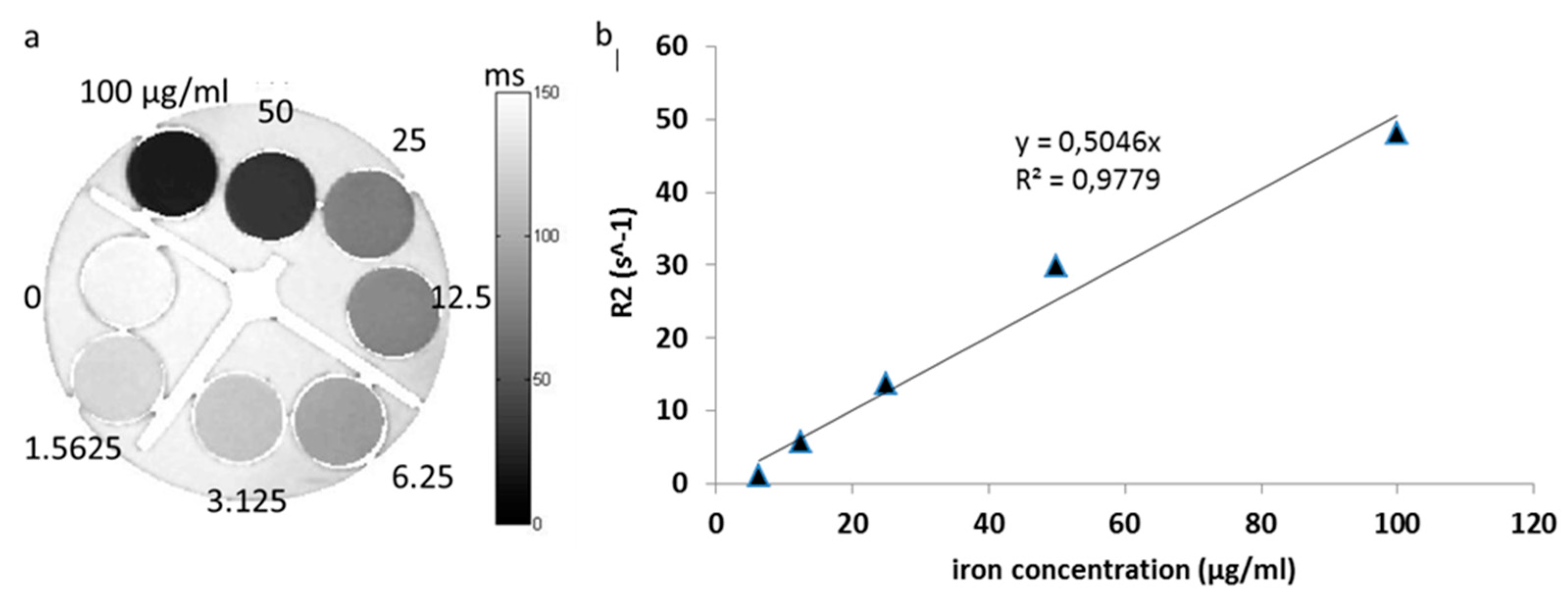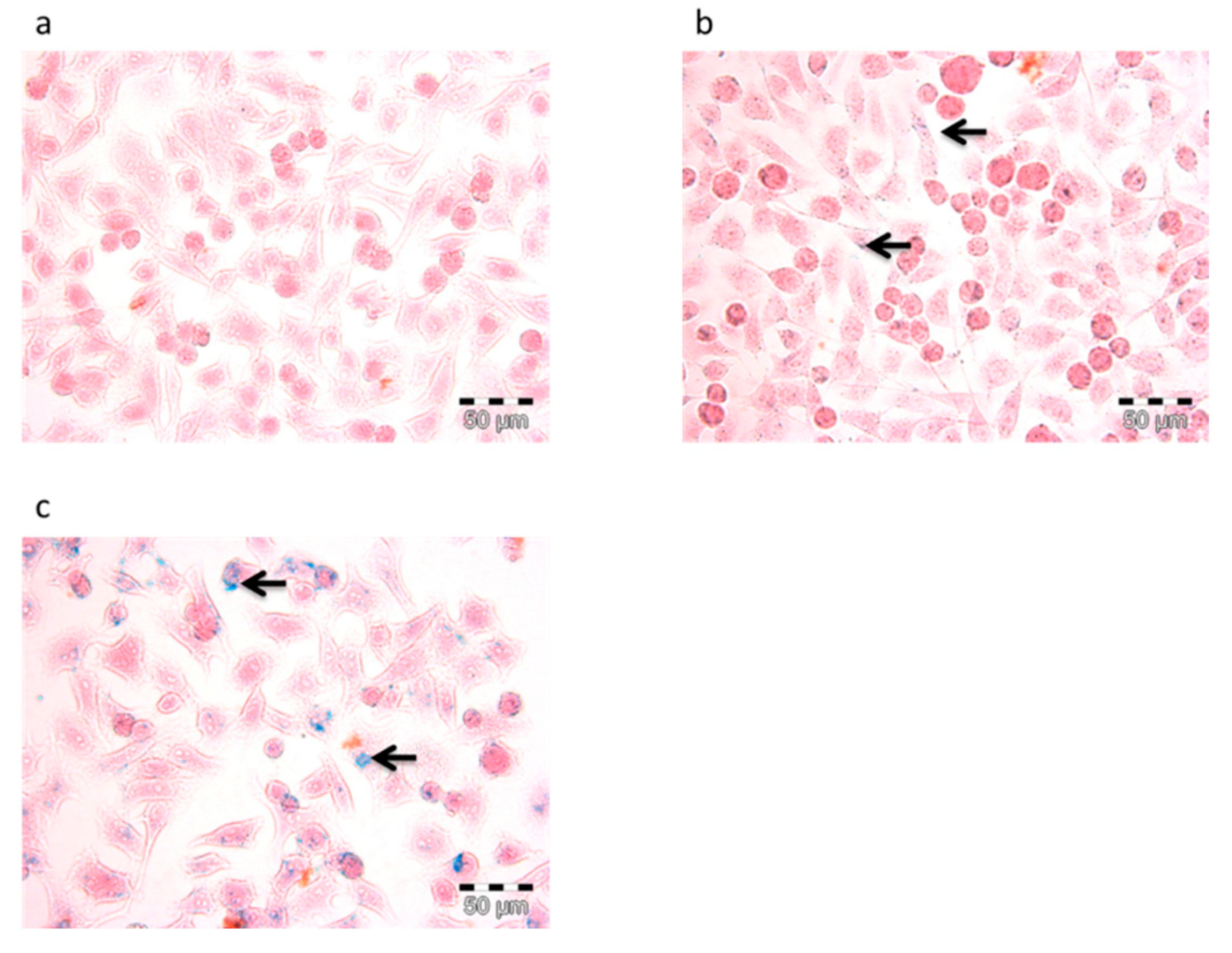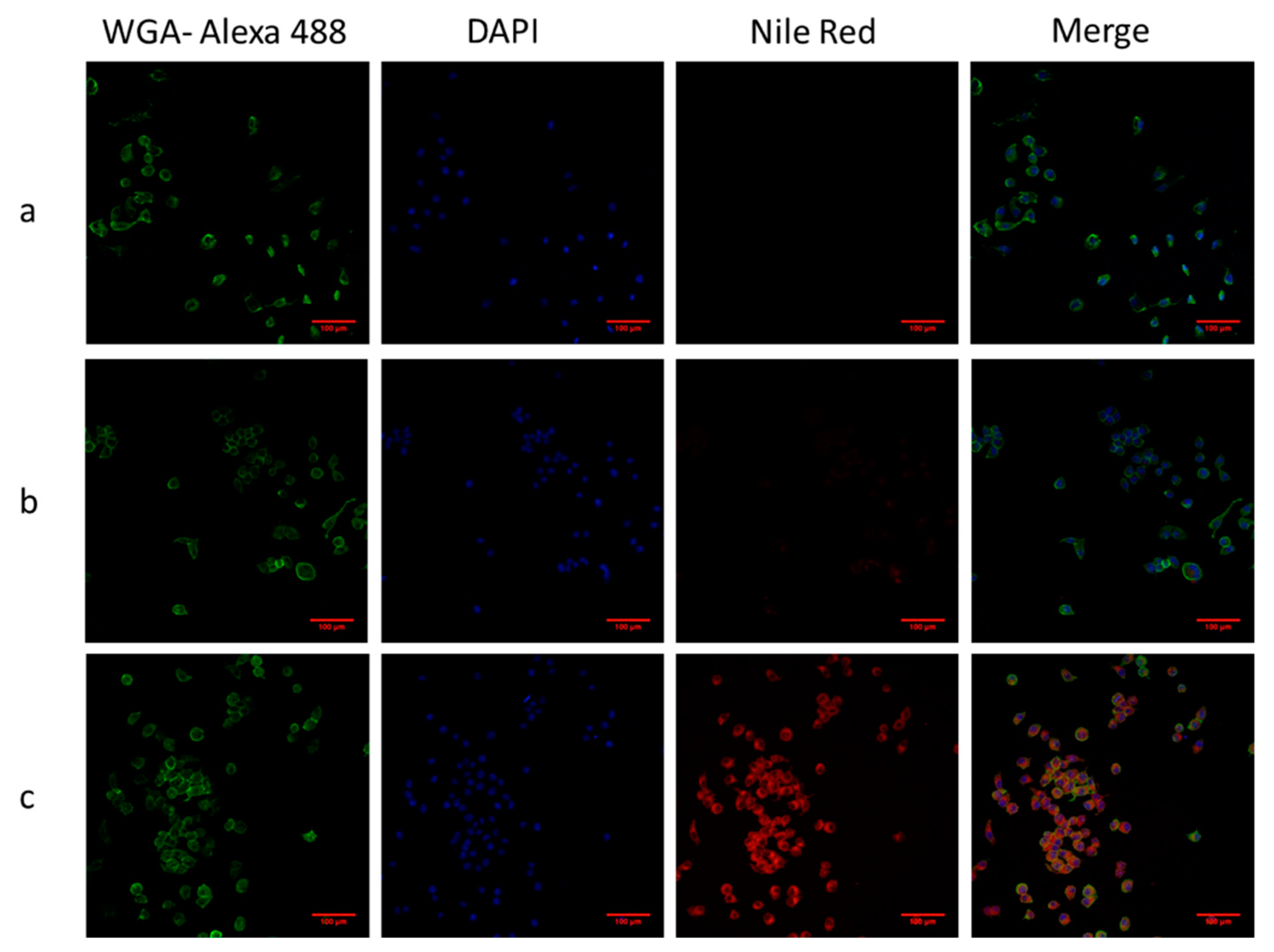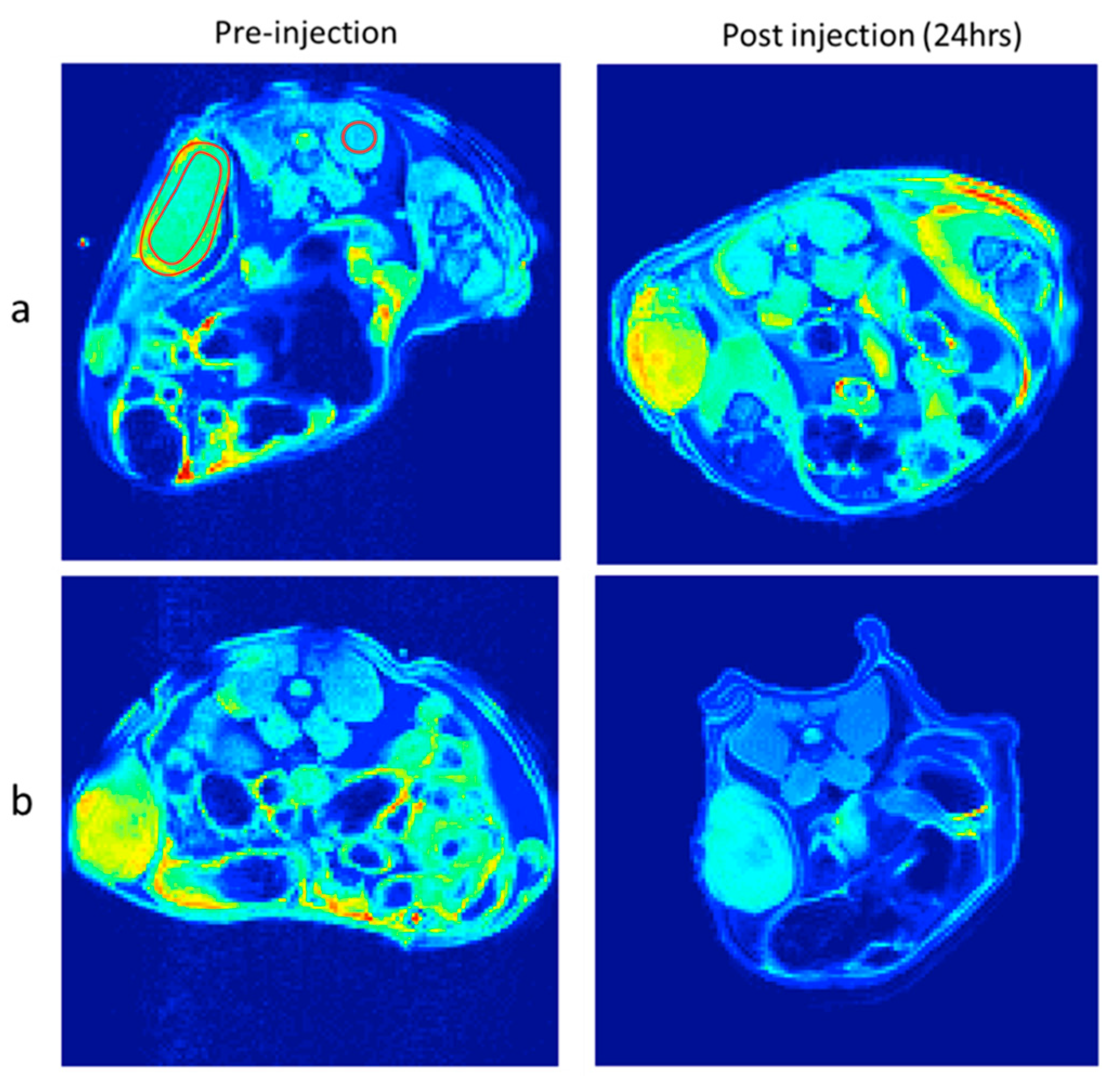Pluronic F127-Folate Coated Super Paramagenic Iron Oxide Nanoparticles as Contrast Agent for Cancer Diagnosis in Magnetic Resonance Imaging
Abstract
:1. Introduction
2. Materials and Methods
2.1. Conjugation of Pluronic F127 and Folic Acid
2.2. Synthesis Magnetic Nanoparticles
2.3. Iron Determination
2.4. F127-Folate Coated SPION and F127 Coated SPION Preparation and Particles Characterization
2.5. Cell Viability and Iron Uptake Concentration
2.6. Prussian Blue Staining
2.7. Confocal Laser Scanning Imaging
2.8. Flow Cytometer Assay (FACs)
2.9. Magnetic Resonance Imaging
2.10. In Vitro Scanning
2.11. In Vivo MRI Scanning
3. Results and Discussion
3.1. Synthesis of Pluronic F127- Folate coated and F127 coated SPION
3.2. Particles Size and Zeta Potential
3.2.1. Size of Particles
3.2.2. Zeta Potential
3.3. Cell Viability
3.4. In Vitro Uptake of Nanoparticles
3.4.1. Prussian Blue Staining and Confocal Laser Scanning (CLSM)
3.4.2. Iron Concentration Measurement and Flow Cytometry Assays (FACs)
3.5. Magnetic Resonance Imaging
3.5.1. T2 Relaxation of Nanoparticles
3.5.2. In Vitro T2 Relaxation
3.5.3. In Vivo T2 Weighted Images
4. Conclusions
Author Contributions
Funding
Conflicts of Interest
Appendix A


References
- Macchia, R.J.; Termine, J.E.; Buchen, C.D.; Raymond, V.; Damadian, M.D. Magnetic resonance imaging and the controversy of the 2003 Nobel Prize in Physiology or Medicine. J. Urol. 2007, 178, 783–785. [Google Scholar] [CrossRef]
- Caravan, P.; Ellison, J.J.; McMurry, T.J.; Lauffer, R.B. Gadolinium(III) Chelates as MRI Contrast Agents: Structure, Dynamics, and Applications. Chem. Rev. 1999, 99, 2293–2352. [Google Scholar] [CrossRef]
- Kim, D.K.; Zhang, Y.; Voit, W.; Rao, K.V.; Muhammed, M. Synthesis and characterization of surfactant-coated superparamagnetic monodispersed iron oxide nanoparticles. J. Magn. Magn. Mater. 2001, 225, 30–36. [Google Scholar] [CrossRef]
- Laurent, S.; Forge, D.; Port, M.; Roch, A.; Robic, C.; Vander Elst, L.; Muller, R.N. Magnetic iron oxide nanoparticles: Synthesis, stabilization, vectorization, physicochemical characterizations, and biological applications. Chem. Rev. 2008, 108, 2064–2110. [Google Scholar] [CrossRef]
- Singh, N.; Jenkins, G.J.S.; Asadi, R.; Doak, S.H. Potential toxicity of superparamagnetic iron oxide nanoparticles (SPION). Nano Rev. 2010, 1, 5358. [Google Scholar] [CrossRef]
- Harisinghani, M.G.; Barentsz, J.; Hahn, P.F.; Deserno, W.M.; Tabatabaei, S.; van de Kaa, C.H.; de la Rosette, J.; Weissleder, R. Noninvasive Detection of Clinically Occult Lymph-Node Metastases in Prostate Cancer. N. Engl. J. Med. 2003, 348, 2491–2499. [Google Scholar] [CrossRef]
- Frangioni, J.V. New Technologies for Human Cancer Imaging. J. Clin. Oncol. 2008, 26, 4012–4021. [Google Scholar] [CrossRef] [Green Version]
- Sosnovik, D.; Nahrendorf, M.; Weissleder, R. Magnetic nanoparticles for MR imaging: Agents, techniques and cardiovascular applications. Basic Res. Cardiol. 2008, 103, 122–130. [Google Scholar] [CrossRef]
- Jokerst, J.V.; Lobovkina, T.; Zare, R.N.; Gambhir, S.S. Nanoparticle PEGylation for imaging and therapy. Nanomed. Nanotechnol. Biol. Med. 2011, 6, 715–728. [Google Scholar] [CrossRef] [PubMed] [Green Version]
- Orringer, E.P.; Casella, J.F.; Ataga, K.I.; Koshy, M.; Adams-Graves, P.; Luchtman-Jones, L.; Wun, T.; Watanabe, M.; Shafer, F.; Kutlar, A.; et al. Purified poloxamer 188 for treatment of acute vaso-occlusive crisis of sickle cell disease: A randomized controlled trial. JAMA 2001, 286, 2099–2106. [Google Scholar] [CrossRef] [PubMed]
- Serbest, G.; Horwitz, J.; Jost, M.; Barbee, K. Mechanisms of cell death and neuroprotection by poloxamer 188 after mechanical trauma. FASEB J. 2006, 20, 308–310. [Google Scholar] [CrossRef]
- Scherlund, M.; Malmsten, M.; Brodin, A. Stabilization of a thermosetting emulsion system using ionic and nonionic surfactants. Int. J. Pharm. 1998, 173, 103–116. [Google Scholar] [CrossRef]
- Jain, T.K.; Foy, S.P.; Erokwu, B.; Dimitrijevic, S.; Flask, C.A.; Labhasetwar, V. Magnetic resonance imaging of multifunctional pluronic stabilized iron-oxide nanoparticles in tumor-bearing mice. Biomaterials 2009, 30, 6748–6756. [Google Scholar] [CrossRef] [PubMed]
- Menon, J.U.; Kona, S.; Wadajkar, A.S.; Desai, F.; Vadla, A.; Nguyen, K.T. Effects of surfactants on the properties of PLGA nanoparticles. J. Biomed. Mater. Res. Part A 2012, 100A, 1998–2005. [Google Scholar] [CrossRef]
- Jain, T.K.; Morales, M.A.; Sahoo, S.K.; Leslie-Pelecky, D.L.; Labhasetwar, V. Iron Oxide Nanoparticles for Sustained Delivery of Anticancer Agents. Mol. Pharm. 2005, 2, 194–205. [Google Scholar] [CrossRef] [Green Version]
- Low, P.S.; Antony, A.C. Folate receptor-targeted drugs for cancer and inflammatory diseases. Adv. Drug Deliv. Rev. 2004, 56, 1055–1058. [Google Scholar] [CrossRef]
- Ross, J.F.; Chaudhuri, P.K.; Ratnam, M. Differential regulation of folate receptor isoforms in normal and malignant tissues in vivo and in established cell lines. Physiologic and clinical implications. Cancer 1994, 73, 2432–2443. [Google Scholar] [CrossRef] [Green Version]
- Kularatne, S.; Low, P. Targeting of Nanoparticles: Folate Receptor. In Cancer Nanotechnology; Grobmyer, S.R., Moudgil, B.M., Eds.; Humana Press: New York, NY, USA, 2010; Volume 624, pp. 249–265. [Google Scholar]
- Lin, J.-J.; Chen, J.-S.; Huang, S.-J.; Ko, J.-H.; Wang, Y.-M.; Chen, T.-L.; Wang, L.-F. Folic acid–Pluronic F127 magnetic nanoparticle clusters for combined targeting, diagnosis, and therapy applications. Biomaterials 2009, 30, 5114–5124. [Google Scholar] [CrossRef] [PubMed]
- Jain, T.K.; Reddy, M.K.; Morales, M.A.; Leslie-Pelecky, D.L.; Labhasetwar, V. Biodistribution, Clearance, and Biocompatibility of Iron Oxide Magnetic Nanoparticles in Rats. Mol. Pharm. 2008, 5, 316–327. [Google Scholar] [CrossRef] [PubMed]
- Jain, T.K.; Richey, J.; Strand, M.; Leslie-Pelecky, D.L.; Flask, C.A.; Labhasetwar, V. Magnetic nanoparticles with dual functional properties: Drug delivery and magnetic resonance imaging. Biomaterials 2008, 29, 4012–4021. [Google Scholar] [CrossRef]
- Choi, H.S.; Liu, W.; Liu, F.; Nasr, K.; Misra, P.; Bawendi, M.G.; Frangioni, J.V. Design considerations for tumour-targeted nanoparticles. Nat. Nano 2010, 5, 42–47. [Google Scholar] [CrossRef]
- Gao, Q.; Liang, Q.; Yu, F.; Xu, J.; Zhao, Q.; Sun, B. Synthesis and characterization of novel amphiphilic copolymer stearic acid-coupled F127 nanoparticles for nano-technology based drug delivery system. Colloids Surf. B Biointerfaces 2011, 88, 741–748. [Google Scholar] [CrossRef]
- Astafieva, I.; Maksimova, I.; Lukanidin, E.; Alakhov, V.; Kabanov, A. Enhancement of the polycation-mediated DNA uptake and cell transfection with Pluronic P85 block copolymer. FEBS Lett. 1996, 389, 278–280. [Google Scholar] [CrossRef] [Green Version]
- Kabanov, A.V.; Alakhov, V.Y. Pluronic® Block Copolymers in Drug Delivery: From Micellar Nanocontainers to Biological Response Modifiers. Drug Carrier Syst. 2002, 19, 72. [Google Scholar] [CrossRef]
- Melik-Nubarov, N.S.; Pomaz, O.O.; Dorodnych, T.; Badun, G.A.; Ksenofontov, A.L.; Schemchukova, O.B.; Arzhakov, S.A. Interaction of tumor and normal blood cells with ethylene oxide and propylene oxide block copolymers. FEBS Lett. 1999, 446, 194–198. [Google Scholar] [CrossRef] [Green Version]
- Lee, R.J.; Low, P.S. Delivery of liposomes into cultured KB cells via folate receptor-mediated endocytosis. J. Biol. Chem. 1994, 269, 3198–3204. [Google Scholar]
- Choi, H.; Choi, S.R.; Zhou, R.; Kung, H.F.; Chen, I.W. Iron oxide nanoparticles as magnetic resonance contrast agent for tumor imaging via folate receptor-targeted delivery1. Acad. Radiol. 2004, 11, 996–1004. [Google Scholar] [CrossRef]
- Bettio, A.; Honer, M.; Müller, C.; Brühlmeier, M.; Müller, U.; Schibli, R.; Groehn, V.; Schubiger, A.P.; Ametamey, S.M. Synthesis and Preclinical Evaluation of a Folic Acid Derivative Labeled with 18F for PET Imaging of Folate Receptor–Positive Tumors. J. Nuclear Med. 2006, 47, 1153–1160. [Google Scholar]











| Sample | Water–PDI (nm) | PBS–PDI (nm) | Cell Medium–PDI (nm) | Particles after 6 Months, Water (nm) | ||||
|---|---|---|---|---|---|---|---|---|
| F127 Coated SPION | 185.2 ± 4.0 | 0.135 ± 0.01 | 192.3 ± 9.6 | 0.138 ± 0.03 | 182.3 ± 4.2 | 0.141 ± 0.1 | 156.7 ± 4.3 | 0.182 ± 0.02 |
| F127-Folate coated SPION | 183.6 ± 2.8 | 0.122 ± 0.01 | 194.4 ± 7.8 | 0.139 ± 0.01 | 174.4 ± 7.8 | 0.109 ± 0.02 | 158.6 ± 4.7 | 0.175 ± 0.02 |
| Sample | Zeta Potential |
|---|---|
| F127 coated SPION | −20.2 ± 0.5 mV |
| F127-Folate coated SPION | −17.15 ± 1.8 mV |
| Position | F127 Coated SPION | F127-Folate Coated SPION | ||||
|---|---|---|---|---|---|---|
| Pre-Injection | Post-Injection | Reduced Signal (%) | Pre-Injection | Post-Injection | Reduced Signal (%) | |
| Tumor rim/back muscle | 1.5 | 1.5 | 99.8 | 1.6 | 1.4 | 85.6 |
| Tumor core/back muscle | 1.3 | 1.5 | 117.7 | 1.8 | 1.4 | 80.3 |
| Whole tumor/back muscle | 1.3 | 1.4 | 108.1 | 1.7 | 1.4 | 83.2 |
© 2019 by the authors. Licensee MDPI, Basel, Switzerland. This article is an open access article distributed under the terms and conditions of the Creative Commons Attribution (CC BY) license (http://creativecommons.org/licenses/by/4.0/).
Share and Cite
Vu-Quang, H.; Vinding, M.S.; Nielsen, T.; Ullisch, M.G.; Nielsen, N.C.; Nguyen, D.-T.; Kjems, J. Pluronic F127-Folate Coated Super Paramagenic Iron Oxide Nanoparticles as Contrast Agent for Cancer Diagnosis in Magnetic Resonance Imaging. Polymers 2019, 11, 743. https://doi.org/10.3390/polym11040743
Vu-Quang H, Vinding MS, Nielsen T, Ullisch MG, Nielsen NC, Nguyen D-T, Kjems J. Pluronic F127-Folate Coated Super Paramagenic Iron Oxide Nanoparticles as Contrast Agent for Cancer Diagnosis in Magnetic Resonance Imaging. Polymers. 2019; 11(4):743. https://doi.org/10.3390/polym11040743
Chicago/Turabian StyleVu-Quang, Hieu, Mads Sloth Vinding, Thomas Nielsen, Marcus Görge Ullisch, Niels Chr. Nielsen, Dinh-Truong Nguyen, and Jørgen Kjems. 2019. "Pluronic F127-Folate Coated Super Paramagenic Iron Oxide Nanoparticles as Contrast Agent for Cancer Diagnosis in Magnetic Resonance Imaging" Polymers 11, no. 4: 743. https://doi.org/10.3390/polym11040743





